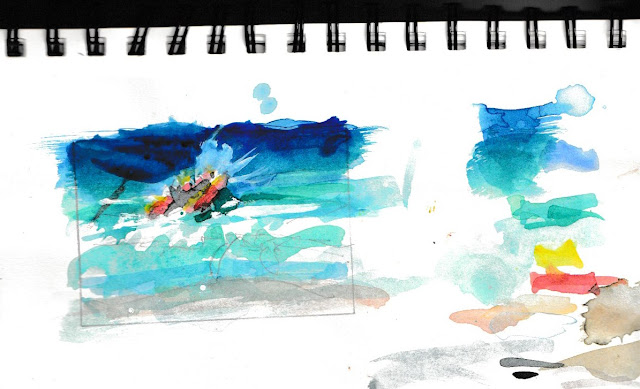The Challenge of Colour Matching
Researching the actual colours and layout to match the Wilcox wheel proved more challenging than anticipated. While reasonable examples of Ostwald's circle exist online, the colours captured and reproduced are, to put it politely, not very reliable. Matching small colour swatches is always difficult, but I was determined to fill the circle with original pigments from watercolour paint tubes I already owned.
Starting with the watercolour paints I had on hand, I managed to fill most pans, purchased a few additional tubes, and eventually had to mix a few colours myself. The result wasn't perfect, but it was a reasonable start that taught me valuable lessons about colour relationships, richest (highest chroma) colour mixes always came from mixes of adjacent pans. It was however, difficult to match the value (lightness or darkness) of colour shown on published wheels; frequently, my watercolour needed to be diluted.
Understanding Oswald's System
The concept behind Oswald's colour circle construction is rooted in opponent colour theory and four psychological colours: red, yellow, green, and blue. These form two pairs—red-green and yellow-blue—creating orthogonal axes in a planar graph.
In Oswald's work, his red was specifically a crimson red, while the green was what he frequently referred to as "sea green"—a bluish green or greenish turquoise. These colours formed the horizontal axis, with the magnitude representing colour intensity: one equalled the most intense red, while minus one represented the most intense green.
The vertical axis featured blue versus yellow, though Oswald famously struggled to find a yellowish blue that wasn't actually green. This challenge led to his systematic approach, with blue positioned on the base and yellow on the top.
The Birth of L*a*b Colour Space
Oswald's work included a third dimension—neutrals ranging from black (absence of light) through shades of grey to white. These three axes became known as L (lightness), a (yellow-blue axis) and b (red-green axis), forming what mathematicians and scientists among colour theorists embraced as the L*a*b colour model. It still forms the basis of the Natural Color System (NCS), and underlying metrics for colour grading in many cinema systems, demonstrating the lasting impact of Oswald's theoretical framework.
The Elusive Sea Green
Reasonable matches for most of Oswald's colour circle elements proved achievable, except for that troublesome sea green. Even after purchasing additional paint tubes, this greenish version of turquoise continued to elude me.The solution came from mixing two adjacent colour elements: the notorious phthalo pigments that stain everything they touch—plastic palettes, synthetic brushes, and inevitably, fingers. These two "dangerous" but strong colours finally yielded a reasonable facsimile of Oswald's elusive sea green.
Nature's Colour Laboratory
The quest for sea green in nature took me down to Venus Bay. The surf beach runs essentially north-south, so late afternoon viewing faces west. In late summer and early autumn, when the sun angle is lowish, sunlight penetrates the waves, illuminating them with a beautiful turquoise, actually a green version of turquoise that even commercial pigments struggle to capture.
A slight offshore breeze lifts the waves, creating pure magic. This natural phenomenon provided the perfect subject matter for sketches, attempting to match these incredible colours with my developing colour chart. The scene was made even more dynamic by local lifesavers training in their IRBs (motorised surf rescue vehicles), jumping waves in displays of both skill and pure joy.The sketches revealed something remarkable: they contained two important Oswald colours—the red of the inflatable rescue boat and the sea green of the illuminated waves. Ostwald's fundamental pair of complementary colours. The composition of horizontal wave lines contrasted with the strong diagonal of the boat created a perfect harmony of colour theory and natural beauty, proving that sometimes the best colour education comes not from books, but from patient observation of the world around us.




No comments:
Post a Comment